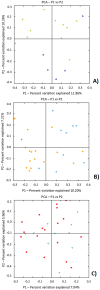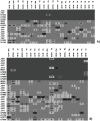Distortions in development of intestinal microbiota associated with late onset sepsis in preterm infants
- PMID: 23341915
- PMCID: PMC3544792
- DOI: 10.1371/journal.pone.0052876
Distortions in development of intestinal microbiota associated with late onset sepsis in preterm infants
Abstract
Late onset sepsis (LOS) is a major contributor to neonatal morbidity and mortality, especially in premature infants. Distortions in the establishment of normal gut microbiota, commensal microbes that colonize the digestive tract, might increase the risk of LOS via disruption of the mucosal barrier with resultant translocation of luminal contents. Correlation of distortions of the intestinal microbiota with LOS is a necessary first step to design novel microbiota-based screening approaches that might lead to early interventions to prevent LOS in high risk infants. Using a case/control design nested in a cohort study of preterm infants, we analyzed stool samples that had been prospectively collected from ten preterm infants with LOS and from 18 matched controls. A 16S rRNA based approach was utilized to compare microbiota diversity and identify specific bacterial signatures that differed in their prevalence between cases and controls. Overall α-diversity (Chao1) was lower in cases two weeks before (p<0.05) but not one week before or at the time of diagnosis of LOS. Overall microbiota structure (Unifrac) appeared distinct in cases 2 weeks and 1 week before but not at diagnosis (p<0.05). Although we detected few operational taxonomic units (OTUs) unique or enriched in cases, we found many OTUs common in controls that were lacking in cases (p<0.01). Bifidobacteria counts were lower in cases at all time points. Our results support the hypothesis that a distortion in normal microbiota composition, and not an enrichment of potential pathogens, is associated with LOS in preterm infants.
Conflict of interest statement
Figures






Similar articles
-
The Microbiome and Metabolome of Preterm Infant Stool Are Personalized and Not Driven by Health Outcomes, Including Necrotizing Enterocolitis and Late-Onset Sepsis.mSphere. 2018 Jun 6;3(3):e00104-18. doi: 10.1128/mSphere.00104-18. Print 2018 Jun 27. mSphere. 2018. PMID: 29875143 Free PMC article.
-
Gut microbiota in preterm infants with late-onset sepsis and pneumonia: a pilot case-control study.BMC Microbiol. 2024 Jul 22;24(1):272. doi: 10.1186/s12866-024-03419-w. BMC Microbiol. 2024. PMID: 39039501 Free PMC article.
-
Longitudinal development of the gut microbiome and metabolome in preterm neonates with late onset sepsis and healthy controls.Microbiome. 2017 Jul 12;5(1):75. doi: 10.1186/s40168-017-0295-1. Microbiome. 2017. PMID: 28701177 Free PMC article.
-
The Potential of Fecal Volatile Organic Compound Analysis for the Early Diagnosis of Late-Onset Sepsis in Preterm Infants: A Narrative Review.Sensors (Basel). 2024 May 16;24(10):3162. doi: 10.3390/s24103162. Sensors (Basel). 2024. PMID: 38794014 Free PMC article. Review.
-
The potential of gut microbiota and fecal volatile organic compounds analysis as early diagnostic biomarker for necrotizing enterocolitis and sepsis in preterm infants.Expert Rev Gastroenterol Hepatol. 2018 May;12(5):457-470. doi: 10.1080/17474124.2018.1446826. Epub 2018 Mar 6. Expert Rev Gastroenterol Hepatol. 2018. PMID: 29488419 Review.
Cited by
-
Gut microbiota maturation during early human life induces enterocyte proliferation via microbial metabolites.BMC Microbiol. 2020 Jul 11;20(1):205. doi: 10.1186/s12866-020-01892-7. BMC Microbiol. 2020. PMID: 32652929 Free PMC article.
-
Association between birth route and late-onset sepsis in very preterm neonates.J Perinatol. 2016 Dec;36(12):1083-1087. doi: 10.1038/jp.2016.146. Epub 2016 Sep 1. J Perinatol. 2016. PMID: 27583393
-
Development of the gut microbiome in early life.Exp Physiol. 2022 May;107(5):415-421. doi: 10.1113/EP089919. Epub 2022 Jan 30. Exp Physiol. 2022. PMID: 35041771 Free PMC article. Review.
-
Bacterial colonization and intestinal mucosal barrier development.World J Clin Pediatr. 2013 Nov 8;2(4):46-53. doi: 10.5409/wjcp.v2.i4.46. eCollection 2013 Nov 8. World J Clin Pediatr. 2013. PMID: 25254174 Free PMC article. Review.
-
Short Course in the Microbiome.J Circ Biomark. 2015 Jul 27;4:8. doi: 10.5772/61257. eCollection 2015 Jan-Dec. J Circ Biomark. 2015. PMID: 28936244 Free PMC article.
References
-
- Neu J (2007) Gastrointestinal development and meeting the nutritional needs of premature infants. Am J Clin Nutr 85(2): 629S–34. - PubMed
-
- Strodtbeck F (2003) The role of early enteral nutrition in protecting premature infants from sepsis. Crit Care Nurs Clin North Am. 15(1): 79–87. - PubMed
-
- Shulman RJ, Schanler RJ, Lau C, Heitkemper M, Ou CN, et al. (1998) Early feeding, antenatal glucocorticoids, and human milk decrease intestinal permeability in preterm infants. Pediatr Res 44(4): 519–23. - PubMed
-
- Kansagra K, Stoll B, Rognerud C, Niinikoski H, Ou C-N, et al. (2003) Total parenteral nutrition adversely affects gut barrier function in neonatal piglets Am J Physiol Gastrointest Liver Physiol. 285(6): G1162–70. - PubMed
Publication types
MeSH terms
Substances
Grants and funding
LinkOut - more resources
Full Text Sources
Other Literature Sources
Medical

